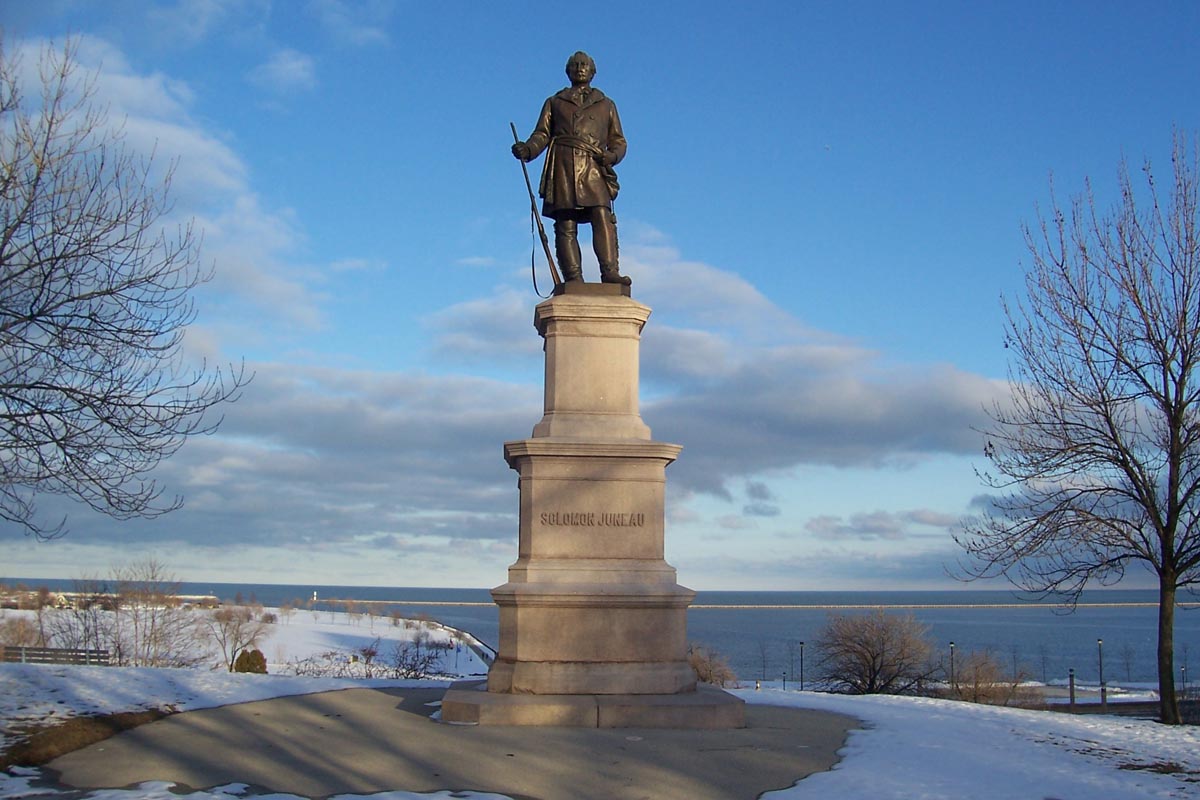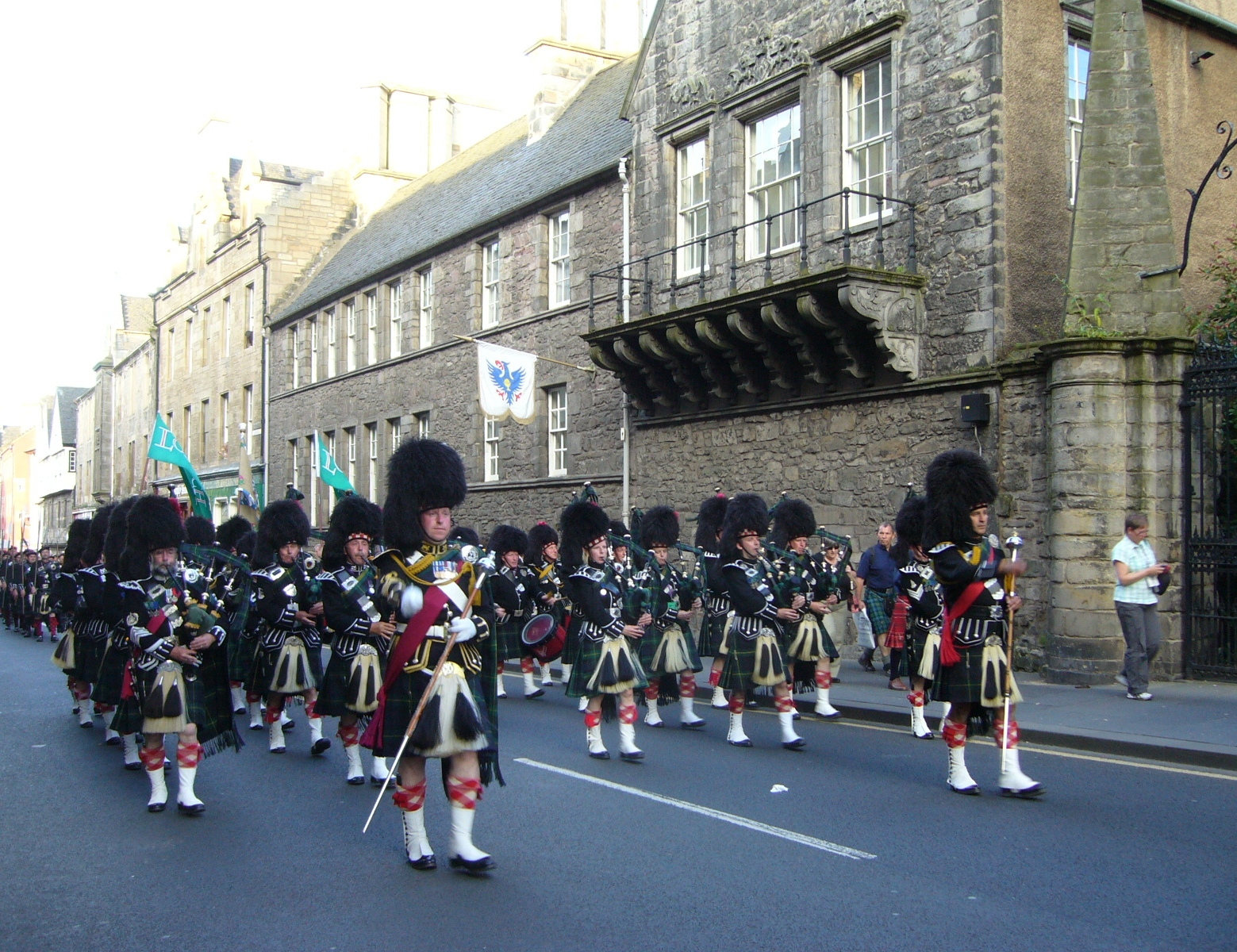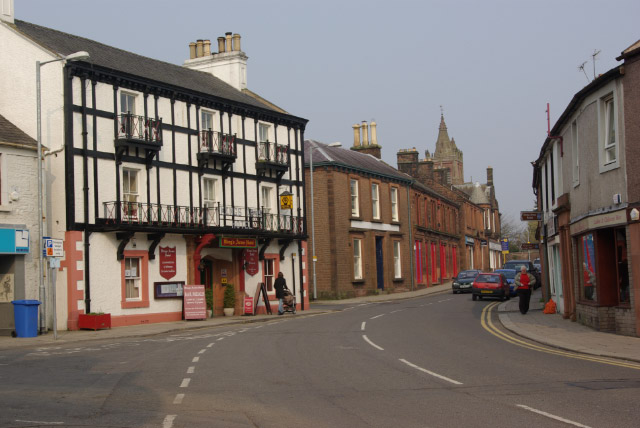|
Robert Burns (Stevenson)
The statue of Robert Burns (also known as the Burns Monument) in Milwaukee, Wisconsin, is a work of public art by the Scottish artist William Grant Stevenson, RSA. The bronze statue, of the Scottish national poet Robert Burns, stands on a plinth of Nova Scotia pink granite with two bronze bas relief panels. The monument was donated to the City of Milwaukee by James A. Bryden. Sculptor William Grant Stevenson was a prolific Scottish sculptor and a member of the prestigious artists' collective the Royal Scottish Academy, to which he was elected in 1896. Stevenson first became world famous for his sculptures of Robert Burns in 1879, when his marble statue was selected from 21 competition entries as the best statue for the Burns Monument in Kay Park, Kilmarnock, Scotland. Stevenson worked out of the Dean Studio in Edinburgh with his brother and fellow sculptor, David Watson Stevenson, RSA. W. G. Stevenson is also recognized for his colossal bronze statue of Sir William Walla ... [...More Info...] [...Related Items...] OR: [Wikipedia] [Google] [Baidu] |
William Grant Stevenson
William Grant Stevenson, (7 March 1849 – 6 May 1919) was a Scottish sculptor and portrait painter. Life and work Stevenson was born in Ratho in Midlothian on 7 March 1849. His elder brother, David Watson Stevenson (1842–1904), was also a sculptor and an elected member of the Royal Scottish Academy. Stevenson is most famous for his colossal bronze figure of Sir William Wallace, which stands on a high plinth of roughly hewn pink granite overlooking Union Terrace Gardens in Aberdeen. His bronze ''Robert Burns'' is the centrepiece of the Burns Monument, Kilmarnock, and copies are located in Milwaukee, Wisconsin (N. Prospect Ave.) and Denver, Colorado (City Park). Stevenson had his studio at 13 Dalry Road and lived nearby at 63 Haymarket Terrace. His most public work is his contribution of three figures to the Scott Monument on Princes Street in Edinburgh: Caleb Balderstone, Peter Peebles, and The Abbess. The three are somewhat lost within the huge complexity of the buildi ... [...More Info...] [...Related Items...] OR: [Wikipedia] [Google] [Baidu] |
Denver
Denver () is a consolidated city and county, the capital, and most populous city of the U.S. state of Colorado. Its population was 715,522 at the 2020 census, a 19.22% increase since 2010. It is the 19th-most populous city in the United States and the fifth most populous state capital. It is the principal city of the Denver–Aurora–Lakewood, CO Metropolitan Statistical Area and the first city of the Front Range Urban Corridor. Denver is located in the Western United States, in the South Platte River Valley on the western edge of the High Plains just east of the Front Range of the Rocky Mountains. Its downtown district is immediately east of the confluence of Cherry Creek and the South Platte River, approximately east of the foothills of the Rocky Mountains. It is named after James W. Denver, a governor of the Kansas Territory. It is nicknamed the ''Mile High City'' because its official elevation is exactly one mile () above sea level. The 105th meridian we ... [...More Info...] [...Related Items...] OR: [Wikipedia] [Google] [Baidu] |
Solomon Juneau
Solomon Laurent Juneau, or Laurent-Salomon Juneau (August 9, 1793 – November 14, 1856) was a French Canadian fur trader, land speculator, and politician who helped found the city of Milwaukee, Wisconsin. He was born in Repentigny, Quebec, Canada to François and (Marie-)Thérèse Galarneau Juneau. His cousin was Joseph Juneau, who founded the city of Juneau, Alaska. Biography After landing at Fort Michilimackinac in 1816, Juneau worked as a clerk in the fur trade before becoming an agent for the American Fur Company in Milwaukee. He had been summoned to the Milwaukee area by Jacques Vieau, a French-Canadian fur trader and the first permanent white settler in Milwaukee, Wisconsin. In 1818 Jacques Vieau hired Solomon Juneau, based on the accounting prowess Juneau had become known for, and Juneau's reputation for being able to deal well with the local native Americans. Juneau later married one of Vieau's daughters, Josette, and went on to found what was to become the City of Milwa ... [...More Info...] [...Related Items...] OR: [Wikipedia] [Google] [Baidu] |
Pipe Band
A pipe band is a musical ensemble consisting of Bagpipes, pipers and drummers. The term pipes and drums, used by military pipe bands is also common. The most common form of pipe band consists of a section of pipers playing the Great Highland bagpipe, a section of snare drummers (often referred to as 'side drummers'), several Scottish tenor drum, tenor drummers and usually one, though occasionally two, bass drummers. The tenor drummers and bass drummer are referred to collectively as the 'bass section' (or in North America as the 'midsection'), and the entire drum section is collectively known as the drum corps. The band follows the direction of the pipe major; when on parade the band may be led by a drum major, who directs the band with a mace. Standard instrumentation for a pipe band involves 6 to 25 pipers, 3 to 10 side drummers, 1 to 6 tenor drummers and 1 bass drummer. Occasionally this instrumentation is augmented to include additional instruments (such as additional percus ... [...More Info...] [...Related Items...] OR: [Wikipedia] [Google] [Baidu] |
Abraham Lincoln
Abraham Lincoln ( ; February 12, 1809 – April 15, 1865) was an American lawyer, politician, and statesman who served as the 16th president of the United States from 1861 until his assassination in 1865. Lincoln led the nation through the American Civil War and succeeded in preserving the Union, abolishing slavery, bolstering the federal government, and modernizing the U.S. economy. Lincoln was born into poverty in a log cabin in Kentucky and was raised on the frontier, primarily in Indiana. He was self-educated and became a lawyer, Whig Party leader, Illinois state legislator, and U.S. Congressman from Illinois. In 1849, he returned to his successful law practice in central Illinois. In 1854, he was angered by the Kansas–Nebraska Act, which opened the territories to slavery, and he re-entered politics. He soon became a leader of the new Republican Party. He reached a national audience in the 1858 Senate campaign debates against Stephen A. Douglas. ... [...More Info...] [...Related Items...] OR: [Wikipedia] [Google] [Baidu] |
Grain Trade
The grain trade refers to the local and international trade in cereals and other food grains such as wheat, barley, maize, and rice. Grain is an important trade item because it is easily stored and transported with limited spoilage, unlike other agricultural products. Healthy grain supply and trade is important to many societies, providing a caloric base for most food systems as well as important role in animal feed for animal agriculture. The grain trade is as old as agricultural settlement, identified in many of the early cultures that adopted sedentary farming. Major societal changes have been directly connected to the grain trade, such as the fall of the Roman Empire. From the early modern period onward, grain trade has been an important part of colonial expansion and international power dynamics. The geopolitical dominance of countries like Australia, the United States, Canada and the Soviet Union during the 20th century was connected with their status as grain surplus c ... [...More Info...] [...Related Items...] OR: [Wikipedia] [Google] [Baidu] |
Utica, New York
Utica () is a Administrative divisions of New York, city in the Mohawk Valley and the county seat of Oneida County, New York, United States. The List of cities in New York, tenth-most-populous city in New York State, its population was 65,283 in the 2020 United States Census, 2020 U.S. Census. Located on the Mohawk River at the foot of the Adirondack Mountains, it is approximately west-northwest of Albany, New York, Albany, east of Syracuse, New York, Syracuse and northwest of New York City. Utica and the nearby city of Rome, New York, Rome anchor the Utica–Rome Metropolitan Statistical Area comprising all of Oneida and Herkimer County, New York, Herkimer Counties. Formerly a river settlement inhabited by the Mohawk people, Mohawk Nation of the Iroquois Confederacy, Utica attracted European-American settlers from New England during and after the American Revolution. In the 19th century, immigrants strengthened its position as a layover city between Albany and Syracuse ... [...More Info...] [...Related Items...] OR: [Wikipedia] [Google] [Baidu] |
Dumfriesshire
Dumfriesshire or the County of Dumfries or Shire of Dumfries (''Siorrachd Dhùn Phris'' in Gaelic) is a historic county and registration county in southern Scotland. The Dumfries lieutenancy area covers a similar area to the historic county. In terms of historic counties it borders Kirkcudbrightshire to the west, Ayrshire to the north-west, Lanarkshire, Peeblesshire and Selkirkshire to the north, and Roxburghshire to the east. To the south is the coast of the Solway Firth, and the English county of Cumberland. Dumfriesshire has three traditional subdivisions, based on the three main valleys in the county: Annandale, Eskdale and Nithsdale. These had been independent provinces in medieval times but were gradually superseded as administrative areas by the area controlled by the sheriff of Dumfries, or Dumfriesshire. A Dumfriesshire County Council existed from 1890 until 1975. Since 1975, the area of the historic county has formed part of the Dumfries and Galloway council ... [...More Info...] [...Related Items...] OR: [Wikipedia] [Google] [Baidu] |
Lockerbie
Lockerbie (, gd, Locarbaidh) is a small town in Dumfries and Galloway, south-western Scotland. It is about from Glasgow, and from the border with England. The United Kingdom Census 2001, 2001 Census recorded its population as 4,009. The town came to international attention in December 1988 when the wreckage of Pan Am Flight 103 crashed there following a terrorism, terrorist bomb attack aboard the flight. Prehistory and archaeology In 2006, ahead of the construction of a new primary and secondary school archaeologists from CFA Archaeology under took excavations. They discovered the remains of a large (27 x 8m) Neolithic British Isles, Neolithic timber hall that dated to somewhere between 3950 BC to 3700 BC. The archaeologists found it was in use for some time as some of the posts had been replaced. Flax seeds were found in the timber hall showing the people were processing flax. This is an extremely rare find with only one other site in Scotland showing evidence of flax produc ... [...More Info...] [...Related Items...] OR: [Wikipedia] [Google] [Baidu] |
Burns Commons
Burns Commons is a park in the Milwaukee County Parks system. It is located on the East Side of the city, bound by Franklin Pl., Prospect Ave., and Ogden Ave. It is split into two sections by Knapp Street. The larger, northern section is landscaped with trees, lawn and walkways, and includes public art. The smaller southern portion holds a statue of Scottish poet Robert Burns. History In 1847, developer James H. Rogers donated the land to the city, making it one of Milwaukee's earliest parks. At the time it was named First Ward Park. It was later named Franklin Square. As stately homes were built around the park, four of the neighboring homeowners took on its upkeep. They provided landscaping and built a fountain. By the turn of the century, the park was known as Baby Park, since the nursemaids in the affluent neighborhood took their charges to the pleasant park. In 1909 a statue of Robert Burns was donated by Scottish immigrant James Anderson Bryden and erected on the south ... [...More Info...] [...Related Items...] OR: [Wikipedia] [Google] [Baidu] |
Alexander Nasmyth
Alexander is a male given name. The most prominent bearer of the name is Alexander the Great, the king of the Ancient Greek kingdom of Macedonia (ancient kingdom), Macedonia who created one of the largest empires in ancient history. Variants listed here are Aleksandar, Aleksander and Aleksandr. Related names and diminutives include Iskandar, Alec, Alek, Alex, Alexandre (given name), Alexandre, Aleks (given name), Aleks, Aleksa (given name), Aleksa and Sander (name), Sander; feminine forms include Alexandra, Alexandria (given name), Alexandria, and Sasha (name), Sasha. Etymology The name ''Alexander'' originates from the (; 'defending men' or 'protector of men'). It is a compound of the verb (; 'to ward off, avert, defend') and the noun (, genetive, genitive: , ; meaning 'man'). It is an example of the widespread motif of Greek names expressing "battle-prowess", in this case the ability to withstand or push back an enemy shield wall, battle line. The earliest Attested langua ... [...More Info...] [...Related Items...] OR: [Wikipedia] [Google] [Baidu] |

%2C_the_Indian_territories.jpg)






